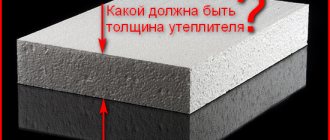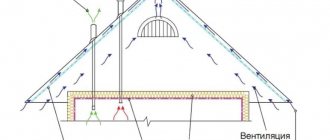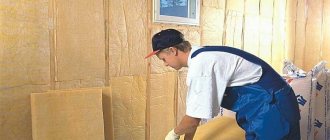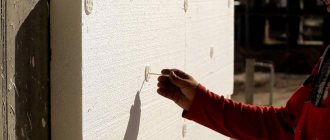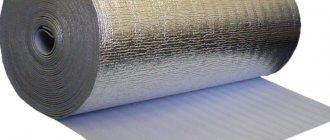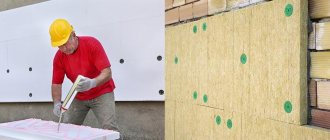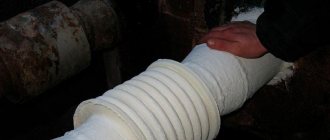The modern construction market is filled with thermal insulation materials of different composition and structure. The energy efficiency of the samples is reflected, among other things, in physical parameters. Let's look at how to calculate the thickness of insulation for walls: calculator, formulas for independent calculations. Let's get acquainted with the sources that must be taken into account during design. After reading the article, it will not be difficult to achieve the optimal result without harm to the home and increasing the cost estimate.
Comparison of thicknesses of materials with identical energy efficiency Source stroybobrov.ru
Popular ways to insulate a home
Thermal insulation of a building can be carried out during the construction stage or after its completion. Among the popular methods:
- Monolithic wall of significant thickness (at least 40 cm) made of ceramic brick or wood.
- The construction of enclosing structures by well masonry is the creation of a cavity for insulation between two parts of the wall.
- Installation of external thermal insulation in the form of a multilayer structure made of insulation, lathing, moisture-proof film and decorative finishing.
Using ready-made formulas, you can calculate the optimal thickness of insulation without the help of a specialist. When calculating, the number should be rounded up; a small margin of the thermal insulation layer will be useful for temporary temperature drops below the average.
How to calculate the thickness of insulation for walls
The first step in calculating the thickness of thermal insulation is determining the thermal resistance that must be compensated for by the thermal insulator. Let's consider examples based on the listed data. Here you need to use the formula R=d/k, where the layer thickness is divided by the thermal conductivity coefficient.
Climatic zones within Russia Source infourok.ru
Here are some options (odds are taken as an average):
- Moscow. 15 cm thick reinforced concrete slab without finishing. In fact, R=0.15/1.7=0.088. 3-0.088=2.911 units are missing.
- Krasnodar. Log house made of logs with a cross section of 20*20. Drywall inside. R=0.2/0.14=1.43. You need to compensate 2.3-1.43-0.16=0.71 sq.m*℃/W.
- Anadyr. Gas foam concrete wall 30 cm thick. The facade is brick, inside there are tiles and plaster. R=0.3/0.145=2.068. The total thermal resistance is: 2.068+0.93+1.05+0.3=4.348 sq.m*℃/W. There are only 4.7-4.348 = 0.352 units missing here.
The next step is to select a thermal insulation material based on efficiency, installation method, and cost. The thickness is determined by the first criterion: d=R*k. Let's look at examples:
- Moscow. Ecowool should be laid in a layer of 2.911*0.034=0.01 m, polystyrene foam 2.911*0.029=0.084 m, expanded polystyrene foam 2.911*0.038=0.11 m. For concrete walls, it would be optimal to use 8.4 cm thick EPS without taking into account finishing materials.
Insulation of a monolithic house under construction with penoplex Source remontuem.if.ua
General information
The thickness of the material is selected depending on the climate of the region. One indicator is provided for the northern republics, and another for the southern republics.
Firstly, the thicker the insulation, the better the heat is retained, and the less energy is spent on heating. Secondly, insulation also saves you from heat. Thirdly, insulation is a good sound insulator.
The thickness varies depending on the type of floor and its location. The floor of the first floor is the coldest, especially if the house is on stilts and is ventilated from below. But it can be earthen if the foundation is strip, and concrete if it is slab.
The floors between floors are heated on both sides. Insulation is used only as sound insulation.
The attic floor is also a floor. It must be insulated, especially if the attic is unheated. Otherwise, the heat will go outside, and in addition condensation will appear on the ceiling.
Insulation thickness under a heated floor system
Each material has its own thermal conductivity coefficient. This parameter is of primary importance when determining the thickness of insulation.
Thermal conductivity of insulation of different densities
The effectiveness of insulation also depends on the density. The higher it is, the more difficult it is for the insulator to retain heat.
Comparison of thermal conductivity of materials
12 cm of polystyrene (density, however, not indicated) will retain heat as effectively as 210 cm of solid red brick.
Calculation of consumption Penoplex insulation (1185x585x50 mm/7 sheets/4.85 m2/0.24 m3)
Fast and inexpensive delivery, as well as unloading and lifting to the apartment on any floor.
Expert advice, assistance in selecting materials and calculating the required quantity.
Return within one month or extended return period until the end of the repair * for only 5% of the cost of materials.
All materials are stored in dry warehouses, have certificates and quality passports.
By clicking on the "Submit" button, you agree to the Privacy Policy
By clicking on the "Submit" button, you agree to the Privacy Policy
Cost of unloading and lifting
The cost of simple unloading of vehicles without lifting to the floor is 1,200 rubles per ton.
The minimum cost for a loader is 300 rubles.
© M-Delivery, 2021
st. Mariupolskaya, 6, office 28. Moscow, 109382
Source
Useful tips
- All calculations must be made before construction begins, at the house planning stage. This way you can significantly save on materials without losing overall useful qualities;
- Excessive insulation of a house is bad. It is necessary to calculate so that the house is not cold in winter and not hot in summer;
- Window openings and doors in a frame house should be small. The greatest heat loss occurs due to poor quality or insufficiently tight windows;
- An insulated double door is a good option for a frame house.
Calculation of consumption Penoplex insulation (1185x585x40 mm/9 sheets / 6.1 m2 / 0.25 m3)
Fast and inexpensive delivery, as well as unloading and lifting to the apartment on any floor.
Expert advice, assistance in selecting materials and calculating the required quantity.
Return within one month or extended return period until the end of the repair * for only 5% of the cost of materials.
All materials are stored in dry warehouses, have certificates and quality passports.
By clicking on the "Submit" button, you agree to the Privacy Policy
By clicking on the "Submit" button, you agree to the Privacy Policy
Cost of unloading and lifting
The cost of simple unloading of vehicles without lifting to the floor is 1,200 rubles per ton.
The minimum cost for a loader is 300 rubles.
© M-Delivery, 2021
st. Mariupolskaya, 6, office 28. Moscow, 109382
Source
Penoizol
This is a liquid version of polystyrene foam, which has the same pros and cons as the solid version. Its advantage is that it can be poured into hard-to-reach places and, after hardening, forms a monolithic coating without seams.
Penoizol
The disadvantages include the fact that you need to think about the method of supplying penoizol for pouring; on high floors this can be a problem. In most cases, penoizol is used during the construction of private houses; when insulating floors in apartment buildings, it is more convenient to use polystyrene foam and penoplex.
The required thickness of the penoizol layer is the same as that of solid foam.
The importance of an additional layer of thermal protection
When constructing a frame made of wood, it is worth knowing about the high thermal conductivity of this material. The board, which is the basis of the structure, quickly gives off internal heat, so the inner layer of thermal insulation may not perform its functions well. Heat transfer bridges must be closed on at least one side. To do this, high-density foam plastic, up to 5 cm thick, is often glued to the external walls of the building. This material will not allow the wood to quickly give off internal heat and will protect the house from temperature changes and moisture.
The foam can be installed under an even layer of outer lining made of plastic or wood. External finishing will become an effective wind protection system and at the same time allow the wall materials to “breathe”. Effective ventilation will prevent the structure from the formation of mold and areas of rot.
It’s easy to calculate an additional layer of insulation - you need to determine the area of the walls:
Swall = Pwall * Vwall.
The Swall parameter can be indicated in the foam order form at the warehouse.
This material cuts well, its cutting and installation do not cause difficulties even for novice craftsmen.
Only two lengths
The length of the slabs has two standards. Thermal insulation with a density of 25 and 35 kg/m3 has a linear length of 1200 mm. The area of such a sheet is 0.72 m2. Insulation with a density of 45 kg/m3 has a slab length that is 2 times greater, equal to 2400 mm. The area also increases in direct proportion to 1.44 m2. Sheets of short length can be transported even in the cabin of a passenger car, and large ones can be transported in the trunk of the same car (just remember to secure the sheets longitudinally during transportation in order to avoid breakage of the plates under the influence of the oncoming air flow).
